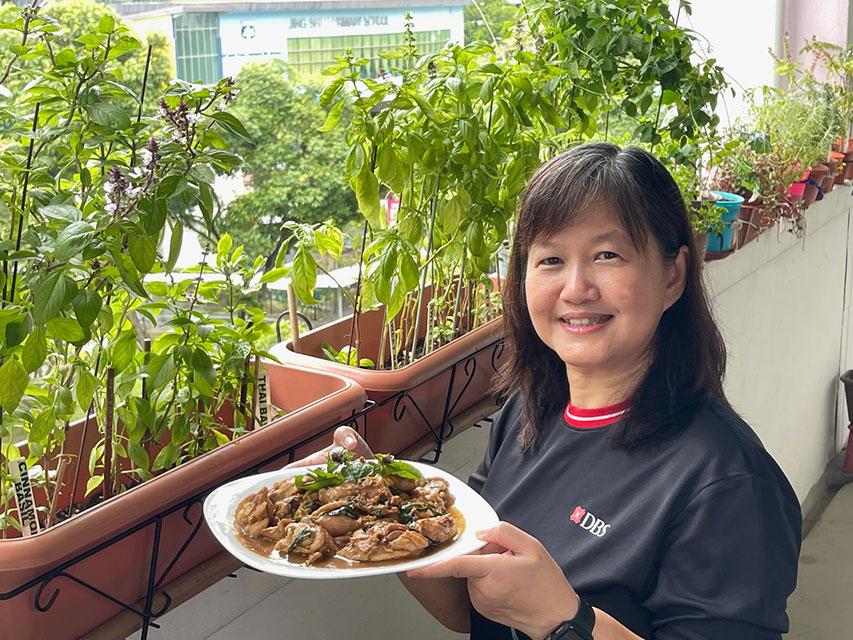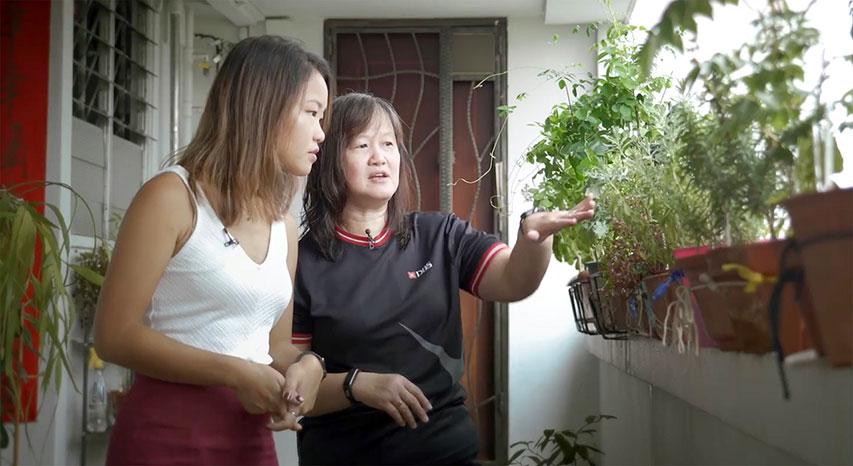
In Sembawang, cauliflower, rocket leaves and raspberries thrive
Instead of buying packs of berries and using just a few for decorating his cakes, Mr Alex Ng grows his own and picks only what he needs.
The 48-year-old hobbyist gardener says: "It is less wasteful as I harvest what I need. I feel a sense of completion when I bake a cake from scratch and garnish it with produce I grow myself."
Since late 2017, the former pastry chef has put his home-based baking business on the back burner to focus on full-time gardening.
He was spurred to do it when he was offered the opportunity to rent a 100 sq m private plot - slightly larger than a badminton court - in Sembawang.
The bachelor lives in a Housing Board flat in Yishun, a 20-minute walk to his garden plot.
He visits the plot daily, where he cultivates temperate crops including cauliflower, cabbage, different varieties of pumpkin, rocket leaves, dill, and an exotic variety of heirloom strawberries called White Soul.
Blackberry and raspberry bushes are grown from seeds of supermarket-bought fruit.
While he loves exotic crops, Mr Ng also grows spinach, kangkong, coriander, spring onion and radish - which are harvested weekly or fortnightly and given to his two sisters.
His elder sister had asked him to grow radish as she uses the vegetable and its leaves to make soup. Radish leaves are usually not sold at markets.
Mr Ng says: "I feel satisfaction and pride being able to provide my sisters with organic produce, even if it is only a small percentage of the vegetables they consume."
He spends about $1,000 a month to maintain his plot, which includes rental and expenses such as water, electricity and gardening materials.
Edible gardening has yielded more than fresh produce for Mr Ng, who gives away most of his harvest to his friends as he seldom cooks.
"Knowing the effort needed to grow edibles has made me appreciate farmers more. It makes me more mindful and avoid wasting food," he says.
He applauds the National Parks Board's efforts to encourage people to grow their own food at home through its Gardening With Edibles initiative, which was launched in June last year.
"It has propelled edible gardening to a national level," he adds.

Mr Alex Ng enjoys the challenge of growing edibles such as raspberries which are not easy to grow in a tropical climate. ST PHOTO: HEDY KHO
Part of a larger effort to build stronger social resilience and well-being in the community, the programme also contributes to food resilience - in line with the Singapore Food Agency's goal to produce 30 per cent of Singapore's nutritional needs locally by 2030.
Free packets of leafy and fruited vegetable seeds - such as cauliflower, radish, pumpkin, winter melon, sword beans and luffa - were given out to interested members of the public. To date, NParks has distributed more than 460,000 packets.
One of the initiative's founding partners is DBS Bank.
As part of its commitment to zero food waste and building a food-secure future, the bank encourages employees to take up home gardening.
It set up a gardening interest group for its staff in July last year, in the hope of raising awareness of the effort needed to grow food and, ultimately, fostering a more mindful approach towards food.
Apart from sharing gardening tips, the 150-member group also aims to cultivate closer social ties amid the pandemic.

Ms Yardley Soo grows a variety of edible plants such as cinnamon basil which she uses to prepare dishes such as basil chicken. ST PHOTO: HEDY KHOO
Joining the group has been life-changing for treasures service officer Yardley Soo, who has been working at the bank for 32 years.
The 55-year-old, who stands at 1.63m and once tipped the scales at 81kg, shed 9kg over the past year.
She started planting Thai basil and garden mint in 2019, then got bored.
Her interest was rekindled after joining the DBS group last year. The edible garden outside her HDB flat started fruiting.
Today, she grows more than 20 varieties of mint such as berries and cream, grapefruit and pear. She also grows sweet basil, Thai basil, cinnamon basil, watercress, curly kale, red kale, oregano and Brazilian spinach.
She uses the herbs and greens to whip up healthy meals. Exercising regularly also helped her shed the kilos.
"Planting a variety of herbs and greens, including those which cannot be bought at the supermarket, allows me to come up with interesting combinations of flavours and textures for my salads and other meals," says Ms Soo, who is married with a 28-year-old daughter.
"They taste good, which motivates me to continue eating healthier."

Ms Soo grows more than 20 varieties of mint such as berries and cream, grapefruit and pear. ST PHOTO: HEDY KHOO
For her salads, she accents supermarket greens with mint, basil, kale and spinach leaves from her corridor garden. Her freshly harvested herbs are so intense in aroma and flavour that her salads need just a light dressing of olive oil and lemon juice.
Growing her own edibles is economical and helps reduce food waste. "In the past, when I had to buy herbs like basil and mint from the supermarket, some went bad if I couldn't consume them in time."
When harvesting mint, basil or spinach, she makes it a point to save the stem cuttings to repot. She then keeps or gives them away.
Joining the gardening group at work has also helped the shy and reserved woman expand her social circle. She got to know more colleagues, who share their gardening knowledge, seeds and stem cuttings of more unusual edible varieties.
Two months ago, she was digging into a salad she had packed from home at her desk and her colleagues said they could smell the fresh mint and basil through their masks.
That kicked off an informal lunch group. Now, Ms Soo and another colleague, who also grows her own edibles, take turns to prepare salads for themselves and two other colleagues.
For the sake of social distancing, they eat at their own desks for now.
"But it is not so lonely because we share our food pictures and exchange comments in our WhatsApp group chat," Ms Soo adds.
How to start and maintain an edible garden
1. Cultivate within your space constraints and pick edibles you will enjoy eating.
A mini edible garden that is affordable to maintain can comprise a few small potted plants of herbs such as basil and Chinese parsley.
Get basic tools and equipment including gardening gloves, a small hoe, a trowel, a gardening fork, secateurs, a spray bottle and a watering can.
2. Many edible plants need at least six hours of sunlight, so place them at an appropriate location outdoors.
For edible gardening indoors, consider using grow lights which are modified to produce more light in the red and blue spectra to promote plant growth.
3. Use healthy soil that is loamy and well-draining. Add compost to improve the quality of soil for growing edibles.
Know the watering needs of your plants as overwatering or underwatering can be harmful. Fertilise the soil to replenish its nutrients.
Pruning your plants is an important part of plant care. Be aware of the common pests of edibles and learn how to manage them.
4. It is recommended that you water your plant at least once a day, preferably early in the morning, to maximise root absorption and reduce water wastage due to evaporation.
Avoid watering your plant in the evening as it can encourage fungal or bacterial growth.
5. All plants require a regular supply of fertilisers. Besides the use of organic or inorganic fertilisers, you can also apply nutrient solution.
6. Use clean water for watering plants. Do not use processed animal-origin fertilisers to avoid introducing pathogens to plant, as well as chemical pesticides.
Wash plants thoroughly with clean water before consuming. If they are not for immediate use, dry harvested plants with a clean cloth or paper towel before storing them in the refrigerator.
Click here to learn more about common problems for first-time plant parents
Tips from Ms Lilian Kwok, director of nursery and horticulture outreach at NParks
This series presented by DBS and The Sunday Times explores the environmental impact of everyday food choices, and how consumers can live more sustainably when it comes to what they eat, and how much they leave behind.
Learn more about how you can continue your journey #TowardsZeroFoodWaste.
Find out more about DBS’ other partnerships and initiatives #TowardsZeroFoodWaste.